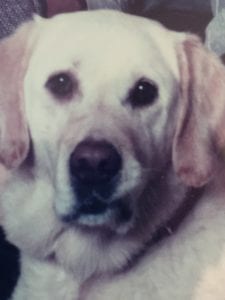Hugh Tunstall-Pedoe
Dundee, Scotland
 |
| Photograph of Petra, courtesy of the author. |
We learn from the life and death of family pets, a microcosm of our own existence. We nurtured Petra, a guide-dog puppy, in our family home for more than a year, after which we handed her over for her formal training. She was welcomed as a star pupil for her social and emotional maturity, her precocious skills, and readiness to acquire more.
Some years later she was offered back to us—if we would have her, now in disgrace—banned from further employment as a guide dog after being accused of aggression by her blind master’s wife. She was overweight, under-exercised, and de-skilled. On arrival, she seemed both emotionally deprived and emotionally fragile, yet deliriously ecstatic to be back in her old home with us. She gradually rehabilitated to her former self with no setbacks or regrets on our part.
Later, with increasing age, she lagged progressively behind on our morning runs on the beach. One summer weekend, her back legs gave out most of the way through the Lairigh Ghru, a mountain pass in Scotland that our family, split in two, was traversing on foot from opposite ends, swapping car keys half-way. She completed the trek to the southern carpark as a passenger in the back of a Land Rover, courtesy of the mountain rescue team, who were delighted to be of service to her.
Some days later, our cleaner phoned me at work, to say that all was not well with Petra and that I should come home. I returned to a completely silent house to find her slumped in front of the Aga cooker in the kitchen, unresponsive, although I convinced myself that her chest was still moving. I phoned fruitlessly for a vet, went back to her, and realized she was dead. It was lunchtime when I phoned my wife at the rural primary school that she headed. “Why did you have to tell me that now, when you know I have the school sports day to manage this afternoon?” “I need to know whether you want to see her again, to say goodbye.” “You decide!” So I pulled the body away from the kitchen’s warmth, to inside the back door where it was cooler—and went back to work.
It was different that evening. My wife leaned over, stroked the inanimate body, and delivered the eulogy. “We all loved you,” she said, “you were the best dog in the world . . . the best there ever was!” Between us, we carried Petra down to the bottom of the garden, where I buried her.
Life’s intimate loves, loyalties, and beliefs, thrive best unchallenged.
Next day, I resumed my alter ego, returning to collaborative research, predicated on objectivity and evidence-based medicine—while privately cherishing memories of Petra as a loving, and much-loved, member of the family.
HUGH TUNSTALL-PEDOE, MA, MD, FRCP (London and Edinburgh), FFPH, FESC, semi-retired, is emeritus professor and senior researcher in the Cardiovascular Epidemiology Unit, Dundee University, Scotland, UK. He studied at Cambridge University and Guy’s Hospital and followed a career in medicine and cardiology in London before becoming a researcher in cardiovascular epidemiology. He moved to Scotland in 1981 to head a research group on cardiovascular disease, was Rapporteur of the WHO MONICA Project from 1979-2003, and initiated the Scottish Heart Health Extended Cohort (SHHEC) whose follow-up he continues. Latterly he was involved in teaching medical ethics.
Summer 2020 | Sections | Personal Narratives

Leave a Reply